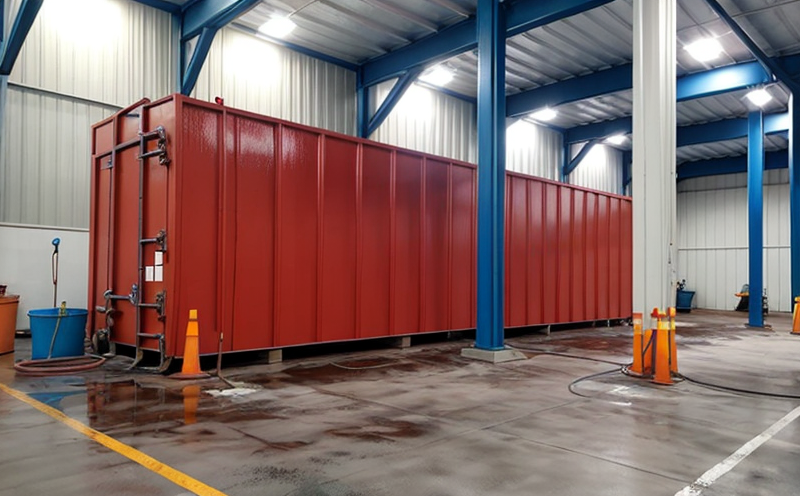ISO 12944 Protective Paint Systems Corrosion Resistance Testing
The ISO 12944 standard provides a comprehensive framework for specifying and assessing protective paint systems used in industrial environments. This testing method is essential to ensure that coatings provide the necessary protection against corrosion, which can lead to costly downtime and maintenance if not addressed properly.
Industrial manufacturing and processing involve numerous processes where equipment and structures are exposed to harsh environments. Corrosion can be accelerated by moisture, humidity, salt spray, and other environmental factors. The ISO 12944 standard addresses these challenges with a series of tests that simulate real-world conditions to evaluate the performance of protective paint systems.
The testing process involves several steps, each designed to assess different aspects of the paint's performance. For instance, the salt spray test simulates exposure to marine environments where corrosion is rampant due to the presence of salt in the air and water. The dew point condensation test replicates conditions found in enclosed spaces such as warehouses or underground structures.
Preparation of specimens for testing is critical; it involves selecting appropriate substrates, cleaning them thoroughly, and applying the paint system according to specified standards. Specimens are then subjected to various tests designed to evaluate their resistance to corrosion over time. The results from these tests help determine whether a particular paint system meets the required performance criteria outlined in ISO 12944.
The standard covers both organic and inorganic zinc-rich paints, as well as other types of protective coatings used on steel surfaces. It specifies test methods that can be applied to assess the corrosion resistance properties of these materials under different exposure conditions. Compliance with this international standard ensures that manufacturers produce reliable products capable of providing long-term protection against rust and degradation.
Understanding the requirements set forth by ISO 12944 helps quality managers, compliance officers, R&D engineers, and procurement professionals make informed decisions about selecting appropriate protective paint systems for their operations. By adhering to these standards, industries can ensure they are meeting regulatory obligations while also improving operational efficiency through enhanced equipment longevity.
For those involved in research and development (R&D), knowing how ISO 12944 defines the parameters necessary for evaluating paint performance is invaluable. This knowledge allows them to design more effective coatings that meet industry needs better than ever before. Moreover, understanding these standards enables procurement teams to specify appropriate materials confidently when sourcing supplies.
The following table provides an overview of some key components covered by ISO 12944:
| Component | Description |
|---|---|
| Substrate Preparation | Involves cleaning and conditioning the surface prior to painting. |
| Paint Application Methodology | Details different ways of applying paint systems based on specific requirements. |
| Environmental Exposure Simulations | Replicates actual operating conditions through controlled testing environments. |
| Data Collection and Analysis | A process for gathering information during tests and interpreting results accurately. |
This standardized approach not only promotes consistency across various applications but also facilitates better communication among stakeholders involved in specifying, manufacturing, applying, and inspecting protective paint systems. As a result, it contributes significantly to reducing risks associated with premature failure due to corrosion.
By leveraging the insights provided by ISO 12944 Protective Paint Systems Corrosion Resistance Testing, organizations can enhance their overall performance by ensuring they are using high-quality materials that deliver superior protection against corrosive elements. This ultimately leads to increased efficiency, reduced maintenance costs, and prolonged asset life.
Industry Applications
The ISO 12944 standard finds application in numerous industries where protective paint systems are critical for preventing corrosion. These include:
- Oil & Gas: Pipelines, storage tanks, and offshore platforms face constant exposure to harsh marine environments.
- Aerospace: Aircraft fuselages and engine components must withstand extreme conditions during flight.
- Automotive: Vehicles undergo rigorous testing under various environmental stressors throughout their lifecycle.
- Petrochemical: Refineries and chemical plants require robust coatings for process equipment exposed to aggressive chemicals.
In each of these sectors, the ability to prevent or slow down corrosion is paramount. Compliance with ISO 12944 ensures that protective paint systems meet rigorous performance expectations, thereby safeguarding assets against damage caused by corrosive elements.
Why Choose This Test
- Comprehensive Coverage: The ISO 12944 standard offers a holistic approach to evaluating protective paint systems' corrosion resistance capabilities.
- Global Recognition: Adherence to this international standard enhances credibility and assures customers of the product's quality.
- Informed Decision-Making: By choosing tests based on ISO 12944, decision-makers gain valuable insights into material performance under realistic conditions.
- Regulatory Compliance: Ensuring compliance with these standards helps avoid potential legal issues and penalties associated with non-conformance.
- Improved Efficiency: Using reliable protective coatings reduces the need for frequent inspections and repairs, leading to cost savings over time.
- Sustainability: Preventing premature failure of equipment through effective protection contributes positively towards sustainable practices within organizations.
The comprehensive nature of ISO 12944 makes it an indispensable tool for ensuring that protective paint systems provide the necessary level of corrosion resistance required in modern industrial settings. Choosing this test ensures that manufacturers and users alike can trust their choices, leading to better outcomes across all relevant sectors.





